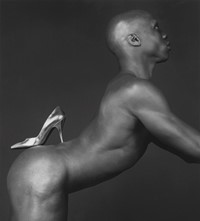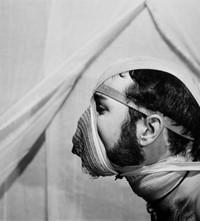As Robert Mapplethorpe selected by Robert Wilson opens at Galerie Thomas Schulte, the avant-garde theatre director and designer remembers his close friend and collaborator
- TextMiss Rosen
In death, Robert Mapplethorpe (1946-1989) has risen to stratospheric heights, his work helping to elevate the medium of photography into the realm of fine art. Whether making portraits of black men, bodybuilders or BDSM fetishists, Mapplethorpe imbued his photographs with exquisite finesse, using classical aesthetics to convey the sculptural beauty of his subjects.
A natural-born provocateur, Mapplethorpe understood how to suffuse his work with the perfect balance of the elegant and the explicit so that the viewer might contemplate each image the same way, no matter what the subject was. He crafted every work with technical precision, directing every element from the lighting to the pose to create an aesthetic democracy, where all things were rendered equal when they appeared before his camera lens. “I look for the perfection of form,” Mapplethorpe said. “I do this in portraits, in photographs of penises, in photographs of flowers.”
On March 14, Galerie Thomas Schulte will present the complete Robert Mapplethorpe: XYZ Portfolios. Created between 1978 and 1981, each portfolio contains 13 photographs each: X features imagery from New York’s gay S&M scene; Y floral still lifes; and Z portraits of black men. The gallery will also present Robert Mapplethorpe selected by Robert Wilson, a selection of prints by avant-garde theatre director and designer Robert Wilson, who was a close friend and collaborator of Mapplethorpe.
As leaders of the New York art scene in the 1970s and 80s, Mapplethorpe and Wilson maintained a dialogue in both image and text, with the photographer making portraits of Wilson alone and with compatriots like Phillip Glass and Susan Sontag. Here, Wilson reflects on their relationship which spanned over two decades as they rose to the pinnacle of the art world.

“I met Bob – I knew him first as Bob – in the late 60s, early 70s, in a supermarket. I was preparing a performance work at the Peerless Movie House on Myrtle Avenue in Brooklyn. We were both students at Pratt Institute. I told him I would present a theatre work, and asked him if he would like to be in it. He said yes. A couple of weeks later I rented the movie house for two hours from midnight on. We knew each other rather casually, and later got to know each other better in the 70s.
“We both were interested in the visual arts and knew some of the same people in the downtown scene. We did not really talk so much about art, but had common friends and social acquaintances. We went to bars and clubs together, often very late at night. We had a few common friends in the gay scene. We both enjoyed the company of our friend Paul Walter, and sometimes had dinner with him and Sam Wagstaff.

“It was a working studio. There was one area with a blank wall where he did almost all of his photos. The room had some objects that he had collected: glass, and ceramics, among other things. He knew exactly what he wanted. He did not take so many shots. He prepared rather quickly, and then shot quickly. Bob was very ambitious and he was a perfectionist. We had a mutual friend who used to do his prints. Bob knew exactly what he wanted.
“We were all terrified [of Aids]. I do not think Aids changed his work. He had a very clear vision of what he wanted. He was able to instruct his assistants, so they could print his work easily, because his style and vision were so concrete. I do not recall exactly the last time I saw him. His health was greatly diminished, but he still was very strong and continuing his work. It was not until shortly before his death that his career started to take off. I am sure that today he would not believe the success he is having now. I kept telling him quite early on that I thought he was one of the great portrait artists of our time.”
Robert Mapplethorpe: X, Y, and Z Portfolios and Robert Mapplethorpe selected by Robert Wilson will be on view at Galerie Thomas Schulte in Berlin through April 18, 2020. The gallery will host two special film screenings of the documentary Mapplethorpe: Look at the Pictures (2016) at the gallery the day after the opening and during Berlin Fetish week.















